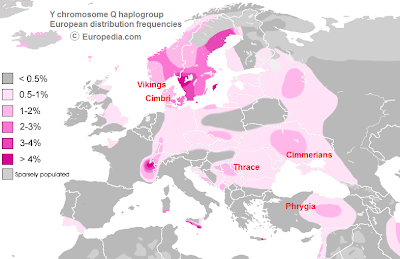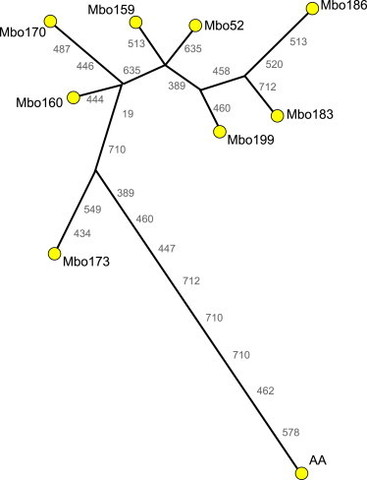Post by Admin on Jan 7, 2016 6:58:41 GMT

The map below shows that hg Q is found in central Europe between an imaginary line that joins Marseille with Hambourg and another joining the Black Sea with Finland. It encompasses large portions of Scandinavia with in pockets in the UK, Iceland, Sicily, South Western Iberia, Cotentin, Dalmacia and South Sardinia. The voids are interesting too, it is absent from most of Western France, Spain, Italy, the Balkans and Slovenia, Belarus and central-western Poland.

The argument behind the Hun Q haplogroup admixture in Europe goes like this: as they were Asians, from central Siberia, apart from other haplogroups, they also carried the Q hg in them. This explains the presence of Q hg in the areas formerly occupied by the Hunnic Empire (central Europe); it is also found in Provence / Burgundy because many huns settled there after their defeat at Chalons. Furthermore, the Huns supposedly employed Scandinavian (i.e. Goth and Heruli) warriors and many Huns marched north with them after being beaten by the Romans, dispersing their Y chromosomes in that area. The Norse peoples (Vikings, Normans) descended from this admixture later spread the hunnic Q hg widely when they raided Europe (ca. 900 CE): this explains its presence France (Cotentin - Normandy), Great Britain (Danelagh), Sicily (conquered by Normans in 1091 CE) and, as they went across the Atlantic, in Iceland, the Shetland and Faroe Islands.

The Scyths were Asians, which after crossing the Araxes (Volga) River invaded Cimmeria ca. 713 BCE, causing them to flee in two directions: One group invaded Asia Minor (Phrygia) and settled in Sinope on the northern coast of Turkey. Another marched west after a fratricide battle on the shores of the Dniester (Tyras) River and then entered Thrace. These Cimmerians from the Chersonesus (Crimea) several centuries later, sent an embassy to Emperor Augustus in Rome with gifts, to ask for pardon for their raids one century before (Plutarch [8] and Strabo [9]).
But the largest part of these people, had migrated from their Crimean home and lived in the wooded lands of Central Europe, along the Danube River and at the sources of the Elbe and the Vistula rivers, which they settled long before the appearance of the Germanic tribes. [10] They were considered Celtic people and they took part in the attack upon Delphi in Greece (279 BCE) allied with the Illyrians, but were defeated. [12]

The Romans at that time occupied the coastal areas around the Mediterranean sea (green in map below), they ignored the homeland of these barbarians who " sallied forth against Italy, being called at first Cimmerians, and then, not inappropriately, Cimbri." [8]. Their twelve year campaing ended in defeat, and they retreated to the north, deep within the forests, into Jutland, which is now Denmark, where, according to Strabo [9] they occupied the country west of the Elbe. A map by Claudius Ptolemy (ca. 90 – ca. 168 CE) that is, roughly 220 years after their invasions, places the land of the Cimbri at the northernmost tip of Jutland.
Their campaign would explain the presence of their Q hg across the central parts of Europe. Its later dispersion from Denmark into Scandinavia and the rest of Europe would be identical to the "Hun's Q hg dispersal" already mentioned above. The presence of Cimbrian Y Chromosomes in the Valley of the Rhone belonged to the refugees escaping the defeat at Vercelli, crossing the Alpine passes into current Savoy and Haute Rhone. Or (chose your option): (1) the survivors of the Cimbri garrison that remained in Belgium (who later became the Aduatuci), after their defeat by Julius Caesar in 57 BCE (most were killed or sold as slaves). (2) Later moves towards the south (400 CE) of the Burgundians from Scandinavia, to current Poland, and finally to France, bearing Cimbrian admixture in their genomes.
An interesting paper (I. Rozhansky, 2010) [11] views the Cimbrians as carrying different haplogroups in their genome, but after being subjected to a bottleneck (the battles against Rome), male lineages were reduced and only a small part of it reached the Jutland refuge after a 1,700 km march. Their long settlement there (100 BC - 400 CE) subjected them to further genetic drift yielding two haplotypes of Q1a3 unique to Scandinavia which date back to a common ancestor 2200 - 2150 ya. (coincidental with the date of the Cimbrian Invasions).
















